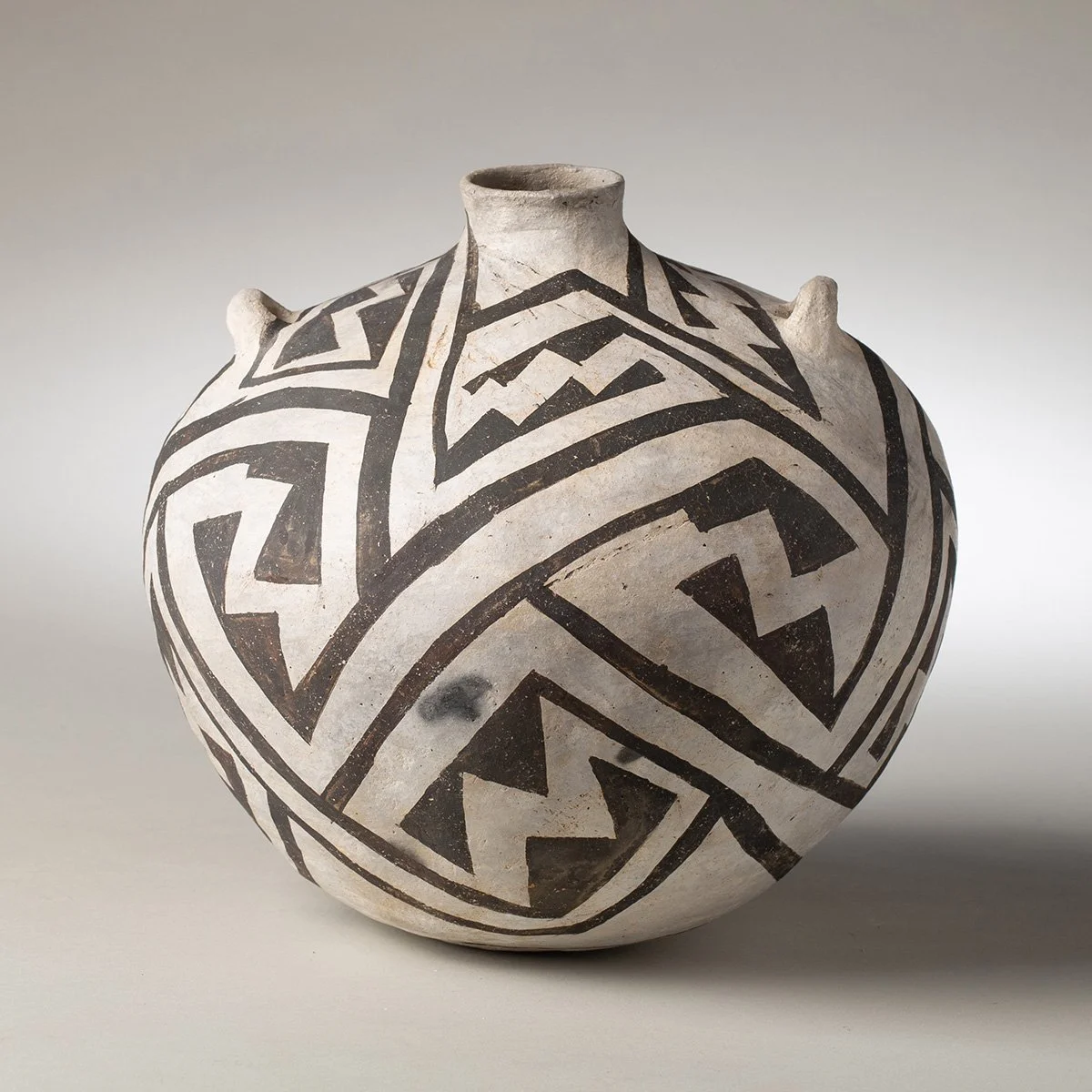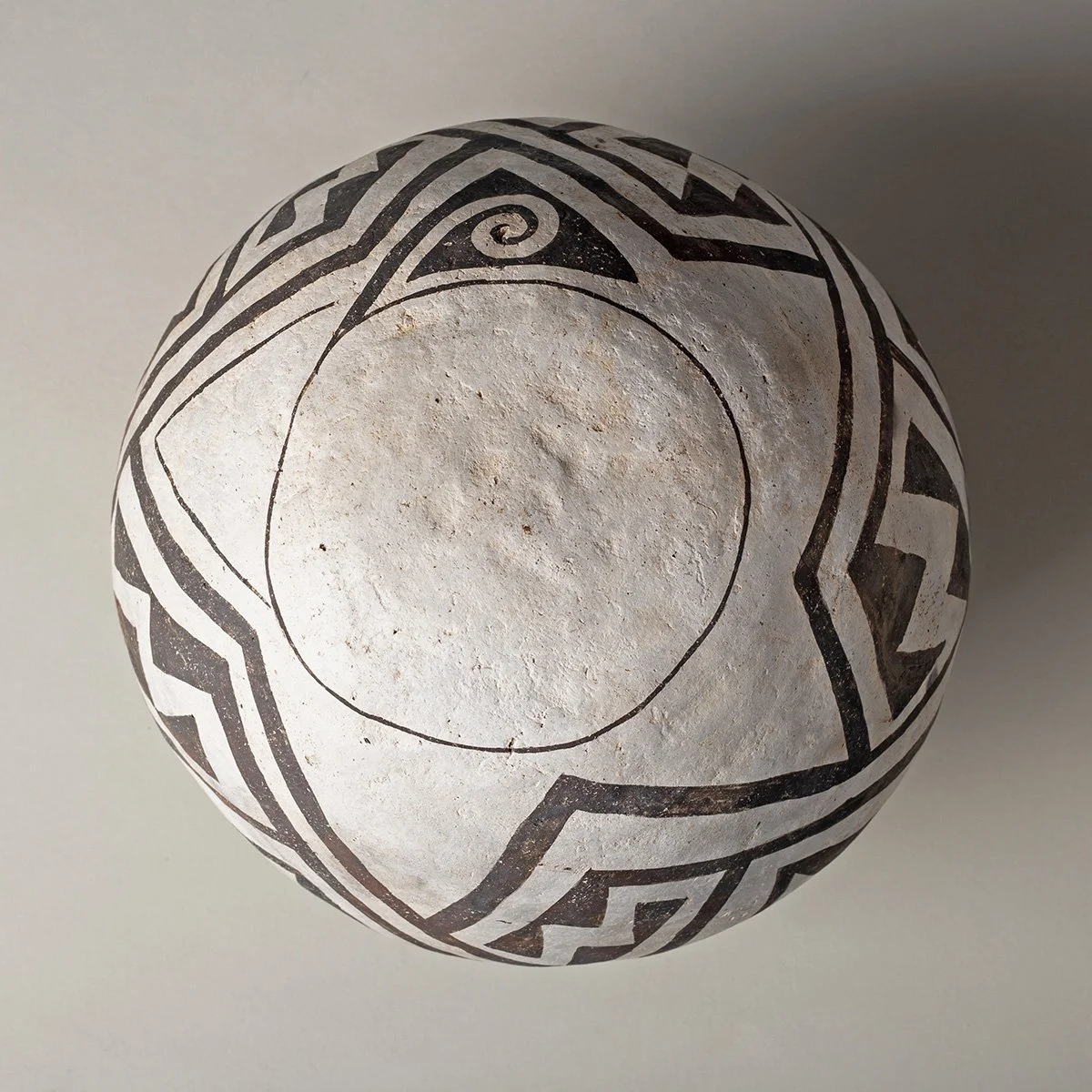Fine Socorro Canteen
New Mexico
950 - 1450 AD
Height 8 3/4" Diameter 9"
Provenance: Billy Schenck, Santa Fe, NM
Socorro Black-on-white was defined by Mera (1935). The area of distribution of Socorro Black-on-white appears to center in lower valley of the Rio Puerco to the East and Rio San Jose, and includes the Rio Salado and Acoma province (Wiseman 2014). Socorro Black-on-white appears to have developed out of Red Mesa Black-on-white. This type is poorly dated but appears to have been produced over a very long span. Pottery that may be assigned to this type may occur from the beginning of the tenth to middle of the thirteenth century (Sundt 1979).
Socorro Black on white is distinguished from other white ware types by distinctive paste, surface characteristics and painted designs (Marshall 1984; Mera 1935; Sundt 1935). Surfaces are usually slightly polished, and sometimes not sliped, although they often exhbit a very thin streaky slip which often light gray. Pastes are gray, hard, and often vitrified. Paint is usually black in color, and it is often dense and vitrified. High firing temperatures often result in a sub-glaze appearance. Temper usually consists of a black angular rock that may occur along with crushed sherd. Petrographic analysis indicates these dark fragments represent basalt and rhyolitic tuff. Socorro Black-on-white is very distinct from contemporaneous pottery types common in areas to the north that were often decorated with organic paint.
Socorro Black-on-white exhibits decorations in mineral paint that most closely resemble Chupadero Black-on-white. Designs include fine lines, hachure, dots, lines appended with dots, checkered squares with and without dots and triangles. Hatched lines tend to be closely spaced. Motifs include opposed solid and hatched combinations. Design layout consists of paneled bands for bowls and wide bands or all over patterns on jars.
References: Marshall, Michael P., and Henry J. Walt. 1984 Rio Abajo: Prehistory and History of a Rio Grande Province. New Mexico Historic Preservation Program, Santa Fe. Mera, H. P. 1935 Ceramic Clues to the Prehistory of North Central New Mexico. Technical Series Bulletin No. 8, Laboratory of Anthropology, Santa Fe. Sundt, William M. 1979 Socorro Black-on-white: Type Description Exchange and Refinement. Pottery Southwest Vol 6, Nol. 3 pp. 4-6.
Intact. Not Found on Federal or State Land
New Mexico
950 - 1450 AD
Height 8 3/4" Diameter 9"
Provenance: Billy Schenck, Santa Fe, NM
Socorro Black-on-white was defined by Mera (1935). The area of distribution of Socorro Black-on-white appears to center in lower valley of the Rio Puerco to the East and Rio San Jose, and includes the Rio Salado and Acoma province (Wiseman 2014). Socorro Black-on-white appears to have developed out of Red Mesa Black-on-white. This type is poorly dated but appears to have been produced over a very long span. Pottery that may be assigned to this type may occur from the beginning of the tenth to middle of the thirteenth century (Sundt 1979).
Socorro Black on white is distinguished from other white ware types by distinctive paste, surface characteristics and painted designs (Marshall 1984; Mera 1935; Sundt 1935). Surfaces are usually slightly polished, and sometimes not sliped, although they often exhbit a very thin streaky slip which often light gray. Pastes are gray, hard, and often vitrified. Paint is usually black in color, and it is often dense and vitrified. High firing temperatures often result in a sub-glaze appearance. Temper usually consists of a black angular rock that may occur along with crushed sherd. Petrographic analysis indicates these dark fragments represent basalt and rhyolitic tuff. Socorro Black-on-white is very distinct from contemporaneous pottery types common in areas to the north that were often decorated with organic paint.
Socorro Black-on-white exhibits decorations in mineral paint that most closely resemble Chupadero Black-on-white. Designs include fine lines, hachure, dots, lines appended with dots, checkered squares with and without dots and triangles. Hatched lines tend to be closely spaced. Motifs include opposed solid and hatched combinations. Design layout consists of paneled bands for bowls and wide bands or all over patterns on jars.
References: Marshall, Michael P., and Henry J. Walt. 1984 Rio Abajo: Prehistory and History of a Rio Grande Province. New Mexico Historic Preservation Program, Santa Fe. Mera, H. P. 1935 Ceramic Clues to the Prehistory of North Central New Mexico. Technical Series Bulletin No. 8, Laboratory of Anthropology, Santa Fe. Sundt, William M. 1979 Socorro Black-on-white: Type Description Exchange and Refinement. Pottery Southwest Vol 6, Nol. 3 pp. 4-6.
Intact. Not Found on Federal or State Land
New Mexico
950 - 1450 AD
Height 8 3/4" Diameter 9"
Provenance: Billy Schenck, Santa Fe, NM
Socorro Black-on-white was defined by Mera (1935). The area of distribution of Socorro Black-on-white appears to center in lower valley of the Rio Puerco to the East and Rio San Jose, and includes the Rio Salado and Acoma province (Wiseman 2014). Socorro Black-on-white appears to have developed out of Red Mesa Black-on-white. This type is poorly dated but appears to have been produced over a very long span. Pottery that may be assigned to this type may occur from the beginning of the tenth to middle of the thirteenth century (Sundt 1979).
Socorro Black on white is distinguished from other white ware types by distinctive paste, surface characteristics and painted designs (Marshall 1984; Mera 1935; Sundt 1935). Surfaces are usually slightly polished, and sometimes not sliped, although they often exhbit a very thin streaky slip which often light gray. Pastes are gray, hard, and often vitrified. Paint is usually black in color, and it is often dense and vitrified. High firing temperatures often result in a sub-glaze appearance. Temper usually consists of a black angular rock that may occur along with crushed sherd. Petrographic analysis indicates these dark fragments represent basalt and rhyolitic tuff. Socorro Black-on-white is very distinct from contemporaneous pottery types common in areas to the north that were often decorated with organic paint.
Socorro Black-on-white exhibits decorations in mineral paint that most closely resemble Chupadero Black-on-white. Designs include fine lines, hachure, dots, lines appended with dots, checkered squares with and without dots and triangles. Hatched lines tend to be closely spaced. Motifs include opposed solid and hatched combinations. Design layout consists of paneled bands for bowls and wide bands or all over patterns on jars.
References: Marshall, Michael P., and Henry J. Walt. 1984 Rio Abajo: Prehistory and History of a Rio Grande Province. New Mexico Historic Preservation Program, Santa Fe. Mera, H. P. 1935 Ceramic Clues to the Prehistory of North Central New Mexico. Technical Series Bulletin No. 8, Laboratory of Anthropology, Santa Fe. Sundt, William M. 1979 Socorro Black-on-white: Type Description Exchange and Refinement. Pottery Southwest Vol 6, Nol. 3 pp. 4-6.
Intact. Not Found on Federal or State Land







